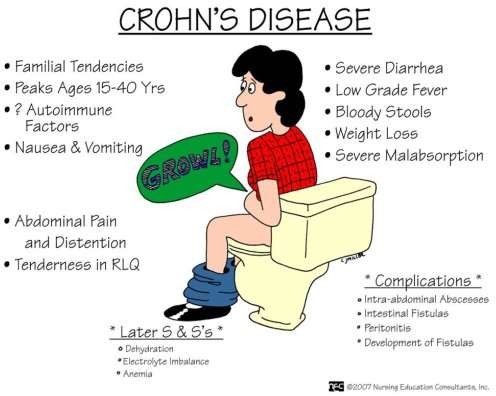A client with Crohn's disease is preparing for discharge from the hospital following treatment for an exacerbation of diarrhea, abdominal pain, and rectal bleeding. Which dietary recommendation(s) should the nurse discuss with the client? (Select all that apply.)
Drink dairy and effervescent sodas for hydration.
Avoid eating fried, fatty foods and large meals.
Enjoy fast food restaurants only if dining with friends.
Limit high fiber foods, such as beans, popcorn, seeds.
Take a vitamin supplement daily with a meal.
Correct Answer : B,D,E
The nurse should discuss the following dietary recommendations with the client who has Crohn's disease:
Avoid eating fried, fatty foods and large meals: Fried and fatty foods can be difficult to digest and may worsen symptoms of diarrhea and abdominal pain. Consuming large meals can also put additional strain on the digestive system.
Limit high fiber foods, such as beans, popcorn, and seeds: High fiber foods can be challenging to digest and may exacerbate symptoms of Crohn's disease. Limiting these foods can help reduce gastrointestinal irritation and promote symptom relief.
Take a vitamin supplement daily with a meal: Crohn's disease can lead to nutrient deficiencies due to malabsorption. Taking a daily vitamin supplement with a meal can help ensure that the client receives essential nutrients and maintain overall nutritional status.
The following options are not appropriate dietary recommendations for a client with Crohn's disease:
- Drinking dairy and effervescent sodas for hydration: Dairy products can trigger symptoms in some individuals with Crohn's disease, especially if they have lactose intolerance. Effervescent sodas may contain carbonation and artificial sweeteners that can aggravate symptoms. Encouraging non-dairy sources of hydration, such as water or herbal teas, would be more appropriate.
- Enjoying fast food restaurants only if dining with friends: Fast food options are generally high in fat, sodium, and other additives that may worsen symptoms in individuals with Crohn's disease. It is advisable to limit or avoid fast food consumption altogether, regardless of whether dining alone or with others.

Nursing Test Bank
Naxlex Comprehensive Predictor Exams
Related Questions
Correct Answer is A
Explanation
A. Correct. Infants with heart failure may tire easily during feedings, so limiting oral feedings to 30 minutes helps prevent excessive fatigue and ensures they are able to feed effectively without becoming overtired.
B. Incorrect. This is not frequent enough for an infant with heart failure. Oxygen saturation should be monitored more frequently, such as every 1-2 hours or as indicated by the clinical situation, to ensure adequate oxygenation and detect any changes promptly.
C. Incorrect. Weighing the infant daily is more appropriate to monitor fluid balance and heart failure progression.
D. Incorrect. Placing the infant in the prone position is contraindicated due to the risk of compromising respiratory function.
Correct Answer is D
Explanation
Choice A rationale:
Oxytocin is not typically administered during a nonstress test. Oxytocin is a hormone that induces or augments labor contractions; it is not used in nonstress testing, which monitors fetal heart rate and movement. The administration of oxytocin during nonstress testing would not be appropriate or necessary.
Choice B rationale:
Fasting is not required for a nonstress test. Nonstress testing involves attaching electronic fetal monitors to the mother's abdomen to measure the baby's heart rate and movement. It does not require the patient to abstain from eating or drinking. Imposing unnecessary restrictions on the client's diet could cause discomfort and anxiety, which is not conducive to an accurate assessment.
Choice C rationale:
Nonstress testing is used to evaluate the baby's heart rate response to its own movements. It does not diagnose genetic problems. Genetic testing, such as amniocentesis or chorionic villus sampling, is a different type of test used to detect genetic abnormalities in the fetus. Therefore, this statement does not reflect an understanding of the purpose of nonstress testing.
Choice D rationale:
This is the correct answer. Nonstress testing involves monitoring the baby's heart rate and movement. During the test, the mother pushes a button when she feels the baby move. This allows the healthcare provider to correlate fetal movements with changes in the baby's heart rate. An understanding of this process indicates that the client comprehends the purpose and procedure of the nonstress test.
Whether you are a student looking to ace your exams or a practicing nurse seeking to enhance your expertise , our nursing education contents will empower you with the confidence and competence to make a difference in the lives of patients and become a respected leader in the healthcare field.
Visit Naxlex, invest in your future and unlock endless possibilities with our unparalleled nursing education contents today
Report Wrong Answer on the Current Question
Do you disagree with the answer? If yes, what is your expected answer? Explain.
Kindly be descriptive with the issue you are facing.
